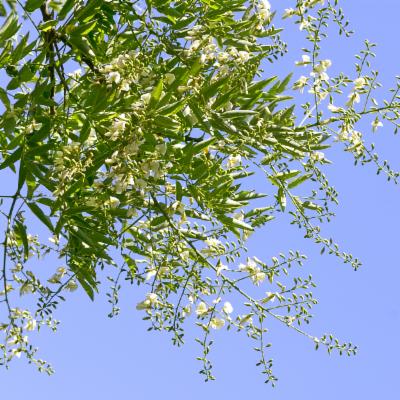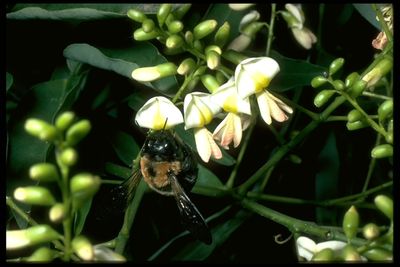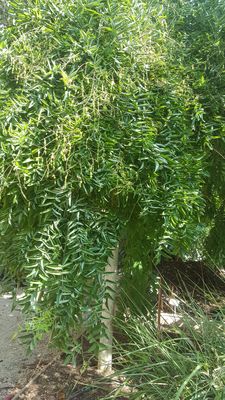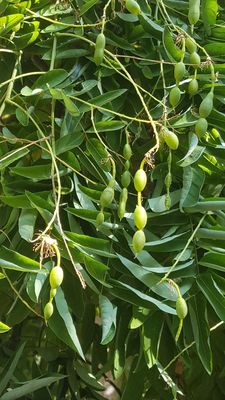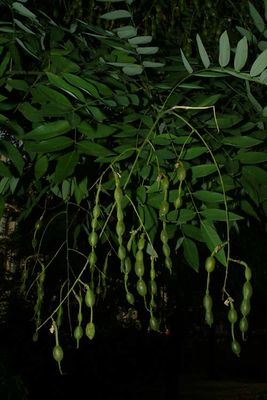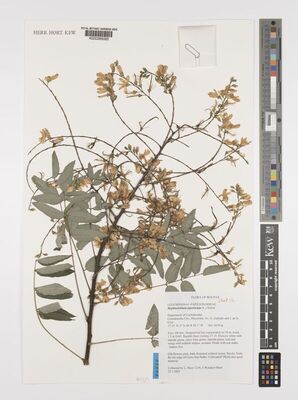Geography and distribution
The pagoda tree is native to China but for a long time has been cultivated and naturalised in Japan, from where the species was originally described. Styphnolobium japonicum is widely cultivated elsewhere in the world, including in the UK.
Description
Overview: Styphnolobium japonicum is a deciduous tree, 15-25 m tall, usually branching low down when growing in the open but capable of forming a tall, clean trunk. The bark of mature trees is grey and corrugated (similar to ash trees).
Leaves: The leaves are pinnate (divided like a feather) and composed of 7-17 ovate to oval leaflets.
Flowers: The creamy white flowers are about 1 cm long and held in showy clusters at the ends of branches.
Fruits: The hairless, necklace-like fruits are 3-12 cm long and 1-8-seeded.
Flowering of the pagoda tree
Styphnolobium japonicum apparently does not flower when young; flowering normally only commences when the tree is 30-40 years old. Old trees flower freely, especially after hot summers. Most flowers fall early to form a dense, white carpet on the ground. The pagoda tree at Kew usually flowers in September, whereas in its native China it flowers in August/September and fruits in October/November.
Threats and conservation
The pagoda tree's conservation status in China is not known; however the tree is widely cultivated and therefore the species is not threatened on a global basis.
Uses
The pagoda tree is grown as an ornamental and for its durable timber, which is used for furniture and construction. The leaves and flowers are edible but the pods are toxic. Yellow and grey dyes extracted from the pods have been used in the silk and batik industries.
This species at Kew
The pagoda tree can be seen growing to the west of the Princess of Wales Conservatory at Kew.
Dried and spirit-preserved specimens of Styphnolobium japonicum are held in Kew's Herbarium, where they are available to researchers by appointment. The details of some of these specimens can be seen online in Kew's Herbarium Catalogue.
Kew's 'Old Lions'
Kew's 'Old Lions' are some of the few remaining trees with the oldest actual known planting date of 1762. They comprise: Ginkgo biloba (maidenhair tree), Styphnolobium japonicum (pagoda tree) and Platanus orientalis (oriental plane) to the west of the Princess of Wales Conservatory; Robinia pseudoacacia (black locust) on the lawn to the front of the Orangery; and Zelkova carpinifolia (Caucasian elm) situated in the Herbarium paddock.
Some of these trees were brought from a neighbouring estate at Whitton which belonged to the Duke of Argyll (the uncle of Lord Bute, the botanical advisor to Princess Augusta). They became part of a new five acre arboretum, laid out by William Aiton, which sat next to the Orangery.
Now, 250 years after these trees were planted, Kew is celebrating the 'Old Lions', which can be seen in all their splendour, still growing in the Gardens.
Why call it the 'pagoda tree'?
The pagoda tree's common name probably arose because it was often planted in the grounds of Buddhist temples. Some of the original pagoda trees in the gardens at Kew were planted near to the Pagoda (built in 1761), presumably because of their Chinese origins and its common name. It is still popular as an ornamental, due to its showy inflorescences (flowering panicles) of creamy white flowers.



